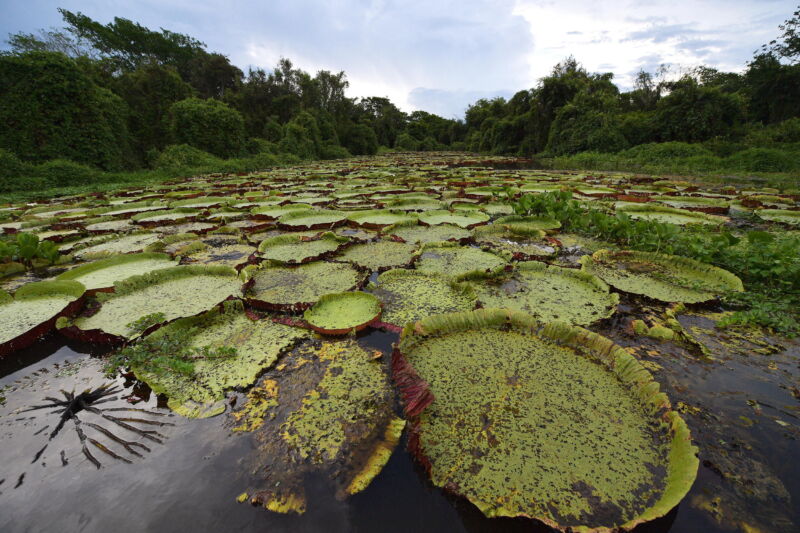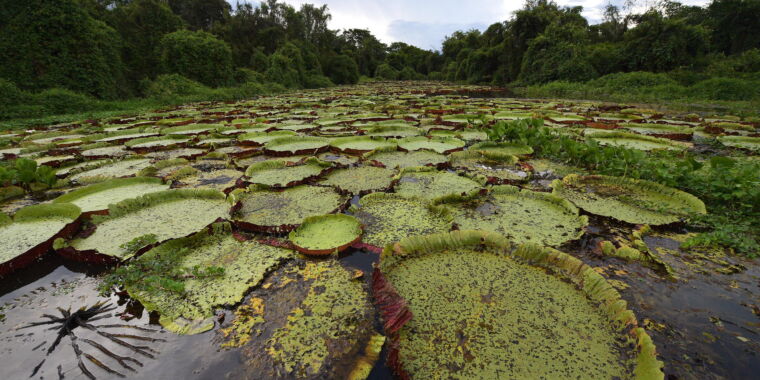
Carl de Souza/AFP via Getty Images
A 2021 pledge by more than 100 nations to cut methane emissions from anthropogenic sources 30 percent by 2030 might not slow global warming as much as projected, as new research shows that feedbacks in the climate system are boosting methane emissions from natural sources, especially tropical wetlands.
A new trouble spot is in the Arctic, where scientists recently found unexpectedly large methane emissions in winter. And globally, the increase in water vapor caused by global warming is slowing the rate at which methane breaks down in the atmosphere. If those feedbacks intensify, scientists said, it could outpace efforts to cut methane from fossil fuel and other human sources.
Methane traps about 80 times more heat than carbon dioxide over a 20-year period, and scientists estimate it’s responsible for 20 to 30 percent of climate warming since the start of the industrial age, when atmospheric methane was at a concentration of about 0.7 parts per million. It has zig-zagged upward since then, spiking with the first fossil gas boom in the 1980s, then leveling off slightly before a huge surge started in the early 2000s. The amount of methane in the atmosphere reached about 1.9 ppm in 2023, nearly three times the pre-industrial level.
About 60 percent of methane emissions are from fossil fuel use, farming, landfills, and waste, with the rest coming from rotting vegetation in wetlands in the tropics and Northern Hemisphere. In a paper published July 30 in Frontiers in Science, an international team of researchers wrote that “rapid reductions in methane emissions this decade are essential to slowing warming in the near future… and keeping low-warming carbon budgets within reach.”
The scientists found that the abrupt surge in methane emissions in the early 2000s is probably due mainly to the response of wetlands to warming, with additional contributions coming from fossil fuel use, “implying that anthropogenic emissions must decrease more than expected to reach a given warming goal.”
Increasing rainfall, a well-documented impact of global warming, is making wetlands larger and wetter, and a warmer world fosters more plant growth, which means more decomposing material that emits methane.
The increase of methane from natural sources should spur even more efforts to cut emissions wherever possible, including from fossil fuel use and agriculture, said lead author Drew Shindell, an Earth scientist with Duke University’s Nicholas School of the Environment.
Recent measurements by a specially equipped jet show that methane emissions from oil and gas operations in the United States are more than four times higher than EPA estimates and eight times greater than fossil industry targets. Addressing methane emissions from anthropogenic sources is a crucial part of the climate action equation, Shindell said, including those from agriculture.
“If we reduced those, we’d see a large decrease in atmospheric concentrations,” he said. “But cutting emissions from agriculture in particular is improbable in the near term, and maybe even in the long term.”
The study reaffirmed that rapid methane cuts are “essential to slowing warming in the near future, limiting overshoot by the middle of the century and keeping low-warming carbon budgets within reach.” The researchers noted that the costs of reducing methane emissions are low compared to many other climate mitigations and that “legally binding regulations and widespread pricing are needed” to encourage the deep cuts that are needed.
Study finds new methane sources from dry permafrost
Scientists determine the source of methane by examining its carbon isotopes, and since 2007, those evaluations show that the signal of methane produced from biological sources “has been getting much stronger,” said Euan Nisbet, an atmospheric scientist and methane expert at the University of Cambridge who was not involved in the new paper.
“There are two explanations, both of them probably correct,” he said. “One is that there are a lot more cows puffing out. But the other one is that the natural wetlands are turning on. That happens in the tropics first, and then the permafrost melts in Canada, and suddenly you get all sorts of methane coming off the Canadian swamps and the Siberian swamps as they wet up.”
Even cold, dry regions in the Arctic contribute to climate-warming methane pollution more than previously thought, according to a July 18 paper in Nature Communications that looked at dry permafrost areas called upland Yedoma Taliks found predominantly in northern Siberia, where permafrost thaw likely will speed up methane production as microbes break down organic material.

